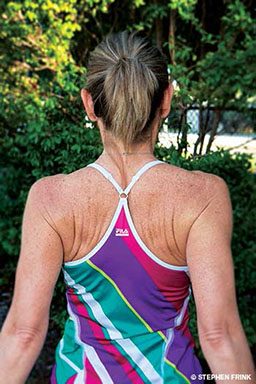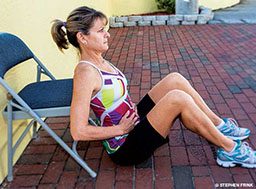Sitting all day is literally killing you. It’s true: The longer you sit, the shorter you live. Prolonged sitting jeopardizes your health by increasing risk of cancer, diabetes, obesity and cardiovascular disease. A hallmark of excessive sitting is a combination of long, weak back and gluteal muscles and short, tight pectorals, abs, hip flexors and quadriceps. Then there’s the sore back, the “spare tire” around the midsection and the diminished brain activity (in the prefrontal cortex). It is quite ironic that all this sitting is frequently done in the name of productivity (at work) and relaxation (watching television).
Prior to quitting your desk job in the name of good health, try these simple steps to increase your daily physical activity. Physical activity is not the same as exercise; these are regular movement breaks that can be incorporated throughout your day without changing out of your work clothes or needing to hit the showers.
It’s pretty simple to combat the effects of sitting if you take the initiative to simply get up. You’ve probably already heard about some methods of increasing your daily steps: taking the stairs, parking farther away and walking to talk to a colleague rather than sending an email. Just taking a moment to stand will “turn on” areas of your brain. These are excellent habits, and you can complement them by incorporating the following stretching and strengthening activities at regular intervals throughout your day.
Shoulder Roll and Retract

Consider your posture as you read this article, drive your car or sit (or slump) at your workstation. Most daily activities occur in front of us, which yields tight anterior (front) musculature and lax posterior (back) musculature, particularly in the shoulder area. Years of poor posture can even lead to kyphosis (humpback) over time. Incorporating shoulder rolls and retractions can combat some of the ill effects of poor posture. This will increase your shoulder mobility by stretching the chest muscles and strengthening the back muscles. It will also promote easier zipping and unzipping of your wetsuit, donning of your BCD and recovery of your hoses.
- Begin seated or, ideally, standing. Maintain good posture throughout.
- Elevate your shoulders toward your ears as high as possible (shrug your shoulders).
- Rotate posteriorly (around toward the back) with a circular motion.
- With shoulders still back, rotate downward.
- Retract your scapula (squeeze your shoulder blades together), and hold for 10 seconds, actively engaging your rhomboids.
Tip: Some people reflexively hold their breath during this static contraction, which is not healthy. Always breathe continuously to avoid a spike in blood pressure.
Lunging Hip-Flexor Stretch (With Stair)

A lunging hip stretch is an excellent activity since it serves to simultaneously strengthen and stretch. This hip stretch targets your hip flexors, which actually shorten from prolonged sitting. It also strengthens your hip and knee extensor muscles.
- Locate a bottom stair or a single stair in a safe area.
- Facing away from the stair, take a giant step forward.
- Place one foot on the stair behind you. Place the sole of your foot on the stair.
- Bend your front knee, slowly lowering your body into the stretch.
- Hold for a five count, then repeat.
Tip: Make sure your back stays in an upright position so you feel the stretch in the front of the crease of your hip.
Challenge: Once you are comfortable, progress to placing the top of your foot on the stair; this will be a less stable position but will provide a greater stretch.

Hip Thrusters
Hip thrusters are the opposite of the deadly desk-sitting position. This activity simultaneously strengthens your back and stretches the front of your body.
- Start sitting on the floor in front of a chair. (Make sure the chair is in a stable position against a wall or desk, especially if it is on wheels.)
- Lean your upper back against the front of the chair.
- Your feet should be closer than shoulder width apart, with the soles of your feet on the floor.
- Lift your butt off the ground so your shoulders, hips and knees are in alignment.

Tip: Ideally your belly should be flat like a table.
DAN Note
To avoid an increased risk of decompression sickness, DAN recommends that divers avoid strenuous exercise for 24 hours after making a dive. During your annual physical exam or following any changes in your health status, consult your physician to ensure you have medical clearance to dive.
© Alert Diver — Q1 Winter 2014